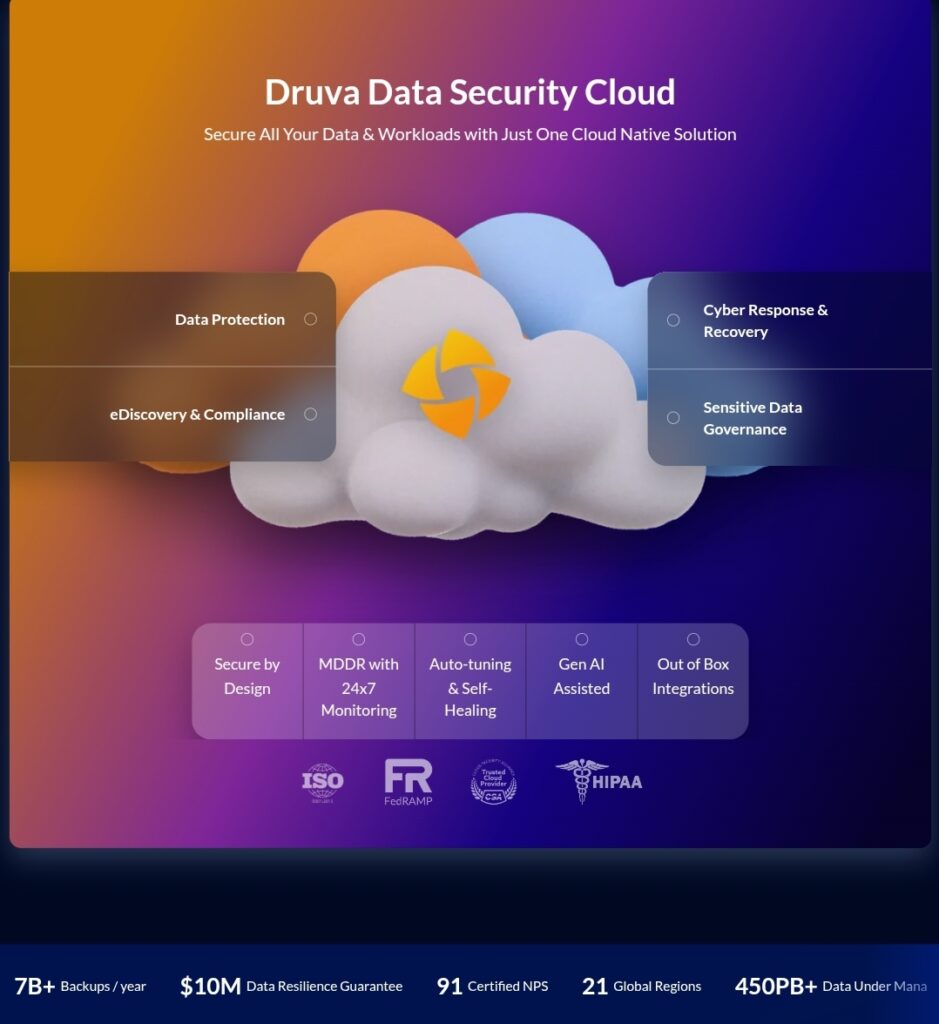Exclusive Networks and Druva Partnership: Transforming Data Protection in India’s Evolving Cybersecurity Landscape
Picture this: A major Indian healthcare provider suddenly discovers that their patient records are encrypted and inaccessible. Ransomware has struck, and outdated backup systems take hours to restore just fragments of critical data. Operations grind to a halt, patient care suffers, and regulatory compliance violations pile up.
This scenario isn’t hypothetical—it’s happening across India with alarming frequency. As organizations accelerate their digital transformation, data has become their most valuable asset and simultaneously their biggest vulnerability. The question isn’t whether cyber threats will target your data, but how quickly you can recover when they do.
The Perfect Storm: India’s Data Security Challenge
India’s cybersecurity landscape is experiencing unprecedented transformation. With information security spending projected to reach $3.3 billion in 2025—a remarkable 16.4% increase from 2024—organizations are clearly recognizing the urgency of robust data protection.
The numbers tell a stark story. Globally, the average cost of a data breach has reached $4.4 million, while cybersecurity spending is set to surge from $193 billion in 2024 to $213 billion in 2025. India’s share of this global spending reflects the country’s growing recognition that traditional data protection approaches simply aren’t adequate for today’s threat landscape.
Why Traditional Solutions Fall Short
Most Indian organizations still rely on legacy data protection systems that were designed for a simpler era. These solutions suffer from critical weaknesses:
Complexity and Cost Overruns: Traditional backup infrastructure requires significant upfront capital investment, ongoing maintenance, and specialized expertise that many organizations struggle to maintain.
Limited Scalability: As data volumes explode—driven by digital transformation initiatives, cloud adoption, and GenAI applications—legacy systems hit scaling walls that create protection gaps.
Slow Recovery Times: When ransomware strikes or systems fail, traditional backup solutions often require hours or days to restore operations, creating devastating business impact.
Fragmented Protection: Organizations juggle multiple point solutions for different environments—on-premises, cloud, and SaaS applications—creating visibility gaps and management complexity.
A Strategic Partnership Addressing Real Needs
The partnership between Exclusive Networks and Druva represents more than just another vendor relationship—it’s a strategic response to India’s evolving data protection challenges. Exclusive Networks, already established as a trusted cybersecurity specialist across 45 countries with offices worldwide, brings deep market knowledge and channel expertise to India’s cybersecurity ecosystem.
Druva’s Data Security Cloud Platform offers a fundamentally different approach to data protection. As a leader in Gartner’s 2024 Magic Quadrant for Enterprise Backup and Recovery Software Solutions, Druva has demonstrated its ability to address modern data protection challenges through cloud-native innovation.
The Channel Partner Value Proposition
This partnership creates compelling advantages for channel partners navigating India’s competitive cybersecurity market:
Industry Recognition and Credibility: Druva’s leadership position in Gartner’s Magic Quadrant provides partners with a proven, analyst-validated solution that resonates with enterprise customers.
Rapid Deployment Capabilities: The platform’s 100% SaaS architecture enables deployment in five minutes or less, allowing partners to deliver immediate value and accelerate project timelines.
$10 Million Data Resiliency Guarantee: This industry-leading guarantee provides partners and customers with unprecedented confidence in data protection capabilities.
Recurring Revenue Opportunities: SaaS-based solutions create sustainable, recurring revenue streams with high Net Revenue Retention (NRR) rates that compound over time.
The Technology Advantage: Cloud-Native Data Security
Modern data protection requires a fundamentally different architectural approach. Cloud-native solutions leverage distributed infrastructure, automated scaling, and built-in redundancy to deliver capabilities that traditional systems simply cannot match.
Key Platform Capabilities
Unified Data Protection: A single platform protects SaaS applications (Microsoft 365, Salesforce, Google Workspace), cloud workloads (Amazon EC2, Azure VMs), and on-premises environments from one centralized console.
Air-Gapped and Immutable Storage: Druva’s architecture ensures backup infrastructure—not just storage—is fully air-gapped and immutable, providing protection against ransomware and data tampering.
AI-Powered Threat Detection: Advanced analytics and 24/7 monitoring capabilities identify potential threats and anomalies, enabling proactive response rather than reactive recovery.
Automated Recovery Orchestration: When incidents occur, automated recovery processes minimize downtime and human error while ensuring data integrity throughout the restoration process.
India’s Cybersecurity Imperative
India’s digital economy growth has created a massive attack surface that cybercriminals are actively exploiting. Recent data reveals the scope of this challenge:
Ransomware Impact: Major attacks have targeted critical infrastructure, including AIIMS Delhi, Telangana and Andhra Pradesh power utilities, and numerous private enterprises, demonstrating that no sector is immune.
Regulatory Pressure: The Digital Personal Data Protection (DPDP) Act of 2023 has heightened compliance requirements, compelling organizations to implement robust data governance and protection frameworks.
Cloud Migration Complexity: As organizations accelerate cloud adoption, they face new data sprawl challenges, particularly with GenAI applications creating unstructured data that requires specialized protection approaches.
The GenAI Data Challenge
The rapid adoption of generative AI presents unique data security challenges. 75% of organizations with GenAI initiatives will shift their spending focus from structured to unstructured data security by 2026, according to Gartner forecasts. This shift requires data protection solutions that can handle diverse data types, implement granular access controls, and maintain data lineage across AI workflows.
Building Data Resilience: Beyond Backup and Recovery
Data resilience encompasses more than traditional backup and recovery—it represents an organization’s ability to maintain business operations despite data-related disruptions. Modern resilience strategies must address:
Proactive Threat Detection
AI-powered analytics continuously monitor data access patterns, identifying anomalies that might indicate insider threats, compromised credentials, or early-stage attacks.
Rapid Recovery Capabilities
When incidents occur, Recovery Time Objectives (RTOs) and Recovery Point Objectives (RPOs) determine business impact. Cloud-native platforms can achieve near-instant recovery for critical systems while maintaining data integrity.
Cross-Environment Consistency
Modern organizations operate across hybrid and multi-cloud environments. Effective data protection requires consistent policies, unified visibility, and seamless recovery capabilities across all environments.
The Economic Case for Modern Data Protection
The financial impact of inadequate data protection extends far beyond initial breach costs. Gartner estimates downtime costs at $300,000 per hour, while recovery from major incidents can take weeks or months.
Total Cost of Ownership Benefits
Infrastructure Reduction: SaaS-based platforms eliminate hardware procurement, maintenance, and refresh cycles, reducing total cost of ownership compared to legacy solutions.
Operational Efficiency: Unified management consoles and automated processes reduce administrative overhead, freeing IT resources for strategic initiatives.
Scalability Without Complexity: Cloud-native architecture scales automatically with business growth, avoiding over-provisioning costs and ensuring adequate protection coverage.
Compliance Automation: Built-in compliance reporting and audit trails reduce manual effort and ensure adherence to regulatory requirements.
Future-Proofing Data Protection Strategies
As India’s cybersecurity landscape continues evolving, organizations must adopt protection strategies that can adapt to emerging threats and technologies.
Emerging Technology Integration
Zero-Trust Architecture: Modern data protection integrates with zero-trust security models, ensuring identity verification and access controls extend to backup and recovery processes.
Blockchain Verification: Immutable ledgers verify data integrity and provide tamper-proof audit trails.
Quantum-Ready Encryption: As quantum computing advances, data protection systems must implement quantum-resistant algorithms to maintain long-term security.

Preparing for Tomorrow’s Challenges
Artificial Intelligence Integration: AI will increasingly power predictive maintenance, automated incident response, and intelligent data classification.
Edge Computing Protection: As computing moves closer to data sources, protection strategies must extend to edge environments while maintaining centralized visibility and control.
Regulatory Evolution: India’s data protection regulations will continue to mature, requiring flexible platforms that can adapt without major architectural changes.
Actionable Recommendations for CX and EX Professionals
Assess Current Data Protection Maturity: Conduct audits of existing backup and recovery capabilities, identifying gaps and compliance issues.
Prioritize Cloud-Native Solutions: Choose platforms that offer true cloud-native architecture rather than cloud-hosted legacy systems.
Implement Unified Protection Strategies: Consolidate fragmented point solutions into unified platforms providing consistent protection across environments.
Test Recovery Capabilities Regularly: Establish schedules to validate not just backup integrity but also actual recovery timelines.
Plan for Scalability: Select solutions that grow with the organization without requiring significant additional investments.
Focus on Business Outcomes: Measure success through metrics like RTO, RPO, and business continuity, aligning investments with strategic goals.
The partnership between Exclusive Networks and Druva marks a pivotal step toward robust data resilience for Indian organizations. By leveraging cloud-native innovation and channel expertise, they aim to shape a safer, more resilient digital future.
As threats grow more complex and regulations tighten, organizations investing now in modern, comprehensive strategies will maintain their competitive edge and customer trust well into the future.

